Uluwatu Temple locally known as Pura Luhur Uluwatu (with Luhur meaning “something of divine origin”). This is one of Bali’s nine key directional temples and one of the most spectacular ones in the entire island, perched on top of a steep cliff approximately 70 metres above sea level. Uluwatu Temple has a unique architecture with palm-frond black roof stacked into the black. The most impressive thing that anyone sees Uluwatu temple are also amazed prime location, precariously between heaven and earth.Giving it a majestic beauty, the virtual maze, bobbing between the floors clouds overhead and the waves lapping against the cliffs at the foot of white foam. As mentioned above the name Luhur means “something of divine origin” and ulu the “land’s end” and watu the “rock” in the old language. The name itself had aptly described what this special temple is all about. Uluwatu Temple or Pura Luhur Uluwatu is regarded as one of the six most important temples in Bali along with Pura Besakih.

The inner sanctum of the pura (temple) is perched at the edge of steep cliffs which tower over Bali’s legendary surf breaks at the south.Most travelers enjoy the view of this temple from two different vantage points, from both northern and southern part of the area.
Uluwatu Temple History
Inscriptions mention that Uluwatu Temple was instigated by Mpu Kunturan, a Majapahit monk who also participated in establishing several other important temples in Bali such as Pura Sakenan in Denpasar, about 1,000 years ago.
And according to the Archaeological Survey of India, the remains found on the site proves that the temple is of made out of a group of stones that came into existence around the 10th century.

A holy priest from eastern Java, Dhang Hyang Dwijendra, then chose Uluwatu Temple to be his spiritual journey’s final worshiping place. Balinese Hindu devotees believe that he reached the highest spiritual point of oneness with deities by a strike of lightning and completely disappeared.

Legend, however, says that Dhang Hyang Dwijendra (also frequently referred to by name as Danghyang Nirartha) was the architect of Uluwatu Temple and several other temples in Bali, Lombok, as well as Sumbawa. Until 1983, Pura Luhur Uluwatu or Uluwatu Temple was hardly accessible and a lightning strike in 1999 set some parts of the temple on fire. The temple has had some restorations since it was first built.
Uluwatu Temple Highlights and Features
Behind the main shrine in one of the courtyards of Uluwatu Temple lies a Brahmin statue facing the Indian Ocean, considered as a representation of Dhang Hyang Dwijendra.

The two entrances to the temple area are split gates with leaves and flowers carvings. In front of each of them are a couple of sculptures shaped like a human body with an elephant head. A heritage of the 10th century is the one-piece winged stone gate to the inside courtyard of Pura Uluwatu. Winged gates are not commonly found on the island. An addition to Pura Uluwatu in the 16th century is Pura Dalem Jurit. There are three statues in it, one of them is of Brahma.
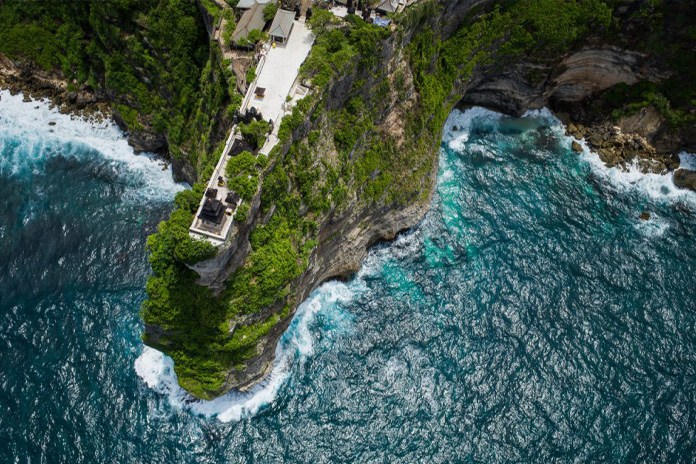
There are two stone troughs in the temple area. If both of them are joined, they create a sarchopagus (Megalithic coffin). Public facilities like toilet, food stall, car park, and souvenir shop are available. But those facilities not in the temple area, its located the parking area infornt of the main gate of the temple.
Uluwatu Temple Ceremony and Festival
Every six months according to the Balinese 210-day Pawukon cycle, big temple anniversary celebrations are held at the temple. The temple’s keeper, the royal family of Jro Kuta from Denpasar, are patrons for the event.

Precautionary signs warn visitors of the monkeys grabbing attractive items such as sunglasses and cameras.
However, they can be calmer when approached with peanuts or bananas, lending an opportunity to retake stolen possessions.

There hasn’t been any significant erosion on the shoreline underneath the temple’s towering cliff. Believers regard it as a manifestation of the divine power that protects Uluwatu Temple or Pura Luhur Uluwatu.
Uluwatu Temple Address & Map Location
Uluwatu Temple is located in the southern tip of Bali, exactly in Pecatu Village, Kuta South District of Badung, Bali, Indonesia. It is at the southernmost of Bali at a place known to tourist as Bukit Peninsula. About 25km south of Kuta and it usually takes around one hour to get to and from there.
How to Get to Uluwatu Temple
Uluwatu Temple sits about 45 minutes from the Denpasar airport and Kuta area by road. There’s no public transportation to get here. The most convenient way to get there is on a guided tour like Uluwatu Temple Tour which combined with Kecak dance and a romantic dinner on Jimbaran Beach.

But it’s also possible to arrive by taxi from just about anywhere on the island, renting Private Car with Driver and taking a Uluwatu Temple Tour to discover some of the best hidden gems!
Uluwatu Temple Entrance Fee
Visits to the Uluwatu Temple are subject to an entrance fee of IDR 15,000 for domestic tourists and IDR 30,000 for foreigners.The ticket can be bought at the ticket counter which located just infront of the main gate of the temple.
And the payment should be cash in Indonesian Rupiah (IDR), so please prepare small cash before you come here.
Visitors must wear a sarong and a sash, as well as appropriate clothes common for temple visits. But its included
Uluwatu Temple Opening Hours
Uluwatu Temple is oper for visitor daily from 09.00 AM to 07.00 PM, and for worship purpose it is open for 24 hours daily.
Generally all time is a good time to visit Uluwatu Temple though you may find some rain in the evening during rainy season.
Come between March to September for the best chance of a clear sunset over Uluwatu.
Uluwatu Temple Drees Code
As we know when you visit of any temples in Bali, both men and women should wear a sarong, scarf or sash tied around the waist.
Sarong and sash is provided in Uluwatu Temple, and you can use that for free, as long as you visit the temple.
Oher conduct tips to follow are:
- Don’t take photos directly in front of worshippers.
- Don’t Step Over or Tread on Offerings – Small offerings called canang sari are often left on the ground. Palm leaves are woven into a small box and flower petals herbs, money, snacks are inside. These offerings are to appease the spirits. Be careful where you’re walking.
- As long as you remember that the temple you are in is a space of reverence to the Balinese people, and treat it as such, your temple visit is sure to bring you the happiness and enlightenment you seek.
Uluwatu Kecak Dance
One attraction not to miss in Uluwatu Temple is the traditional Balinese dance call Kecak dance which is scheduled after the sunset. These performances are obviously for tourist benefit only, and are not spiritually significant to the temple.

However, they are an interesting way to get a glimpse into Balinese performance art, and the setting is stunning.
The Kecak Dance show is held at the open stage of Uluwatu Temple. The show starts at 6 PM and concludes shortly after sunset. The troupe of around 75 male dancers descend onto the stage with extended arms and shaking hands up in the air while chanting their fast-paced, ‘chak!’ choruses repetitively.

The prelude opens the five episodes taken from the Ramayana epic, as dancers in elaborate costumes artistically re-enact the tale with slower or faster tempos provided by the troupe complementing a scene of romance or suspense. The Kecak Dance in Uluwatu Temple synopsis goes that Sri Rama, the prince of the Ayodya kingdom was sent into exile by his father King Dasaratha following an evil trick by his stepmother Kaikeyi. Deep in a monkey forest (which fits in perfectly with Uluwatu’s setting), Rama is accompanied by his wife Sita and loyal younger brother Laksamana. The evil Rahwana, who had a crush on Sita, knew of this, and set out to kidnap her. The rescuing effort by the two brothers ensues with help from the monkey king Hanoman and his monkey troops. Rahwana eventually subdued, the two lovers are finally reunited right after the setting sun.
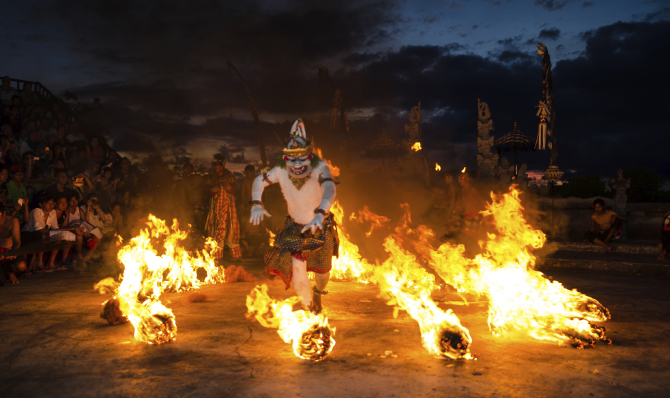
The fire torches in the stage’s centre flicker against the darkened sky and the echoing chants subside.
Tickets or entrance fee of Kecak Dance is Uluwatu is IDR 150,000 per person can be purchased in advance, and arriving early is advised, and the stage has limit space or seating. We recommend getting to the stage early before 5 PM to get the best seats. You can then watch the fire dance with a stunning backdrop of the sunset.
Uluwatu Temple Sunset
Uluwatu Temple dates back to the 11th century and is situated at land’s end to protect from evil spirits. Made from black coral rock, the tiered shape of the sea temple has a dramatic contrast against its precarious location and creates the most amazing silhouette at sunset.

The entrance to the ancient Hindu temple is through an archway decorated with statues of the Hindu elephant deity Ganesha. Behind the main pagoda is a statue said to be of the founding priest, Dwijendra, as well as a shrine shaped like the boat he arrived in. Despite its age, the temple has well-preserved stone carvings and has undergone several restorations to preserve its history and unique location.
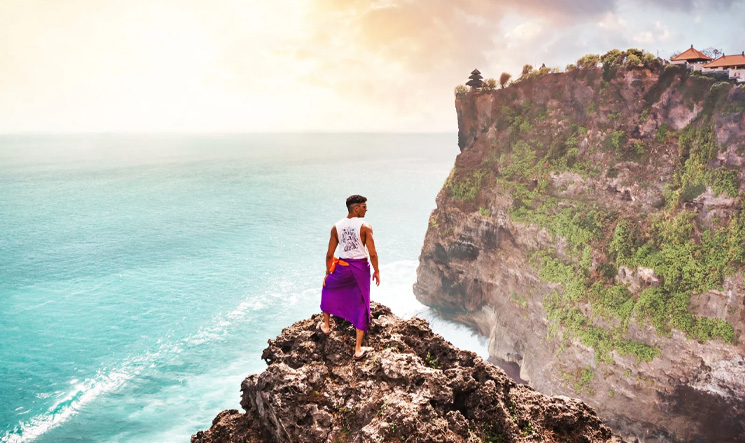
Access to the inner temple is for Hindu worshippers only, and you’ll need to dress in respectful attire when you visit. Another unusual attribute of Uluwatu Temple is its animal inhabitants. The grounds of the temple are home to a troop of mischievous monkeys and warning signs abound to ensure you keep your belongings safe and away from swift simian hands.
But really, this site is all about the view. Sunset is best admired from two vantage points to the north and south of the temple.
Uluwatu Monkey Forest
A small forest lies at the front and hundreds of monkeys dwell here. They are believed to guard the temple from bad influences. The serpentine pathway to the temple is fortified by concrete walls on the cliff side. Thick hedges of green shrubs and plants dot the white cliff face, with frangipani trees, and these simians dominating most of the Bukit area.
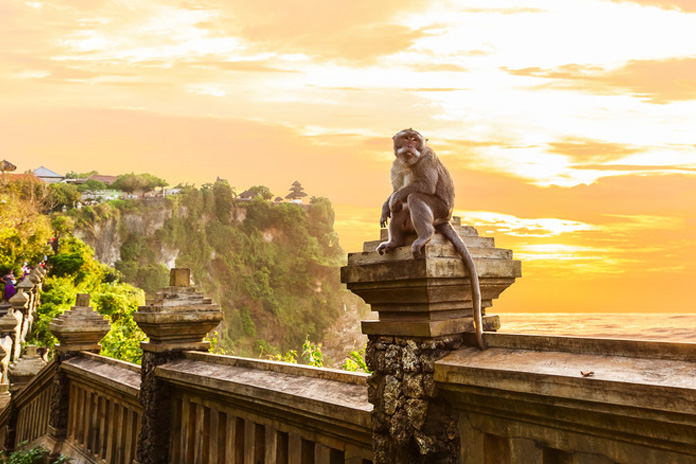
Uluwatu Monkey Forest surrounds the cliff edges near the namesake temple, where hordes of grey long-tailed macaques dwell, adding an exotic and animate feature to the splendid landmark, together with its splendid sea and sunset backdrop.
Regular pilgrims face all sorts of mild mishaps, be it a man’s traditional headdress being seized and taken high up into the trees to never return to its rightful owner, or a playful pair snatching at fruit offerings that haven’t even properly been ‘presented’ to the gods of the temple beforehand. While virtually all of the temple grounds, being accessible to the monkeys, play open stage to their playful exploits once in a while, the surrounding hilly forests outside the temple complex are where they are truly at home. The monkeys are known to come out of their forest dwellings and linger around onto the pathways in the afternoon and down to sunset.
Uluwatu Beach & Surf
Uluwatu Beach is located deep under the cliff bank featured by the great and fast waves that make it as one of the best surf points in the island of paradise. The waves are great, fast, powerful and barrel that force every surfer to use their top skill to enjoy the surf adventures here. It is the most favorite surf points for pro-surfers to execute their surf style on waves hence this place is many visited by surfers from foreign countries including local surfers.
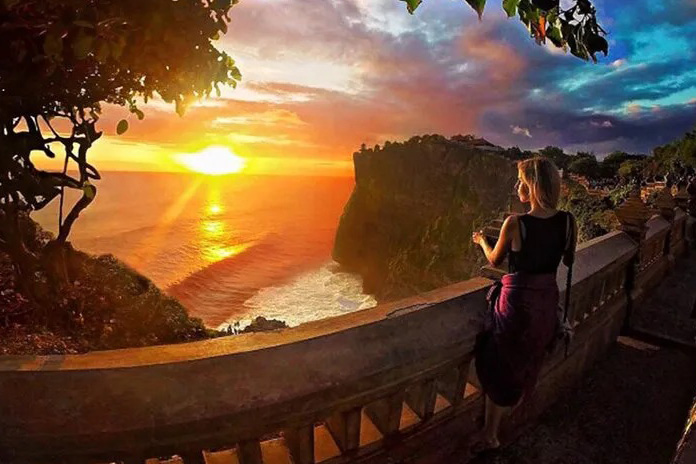
Uluwatu Beach has been drawing in tourists and surfers in growing numbers since the early 1970s. Uluwatu’s potential for incredible surfing first caught the attention of global audiences with the release of the Australian environmental surf documentary “Morning of the Earth” in 1971. This film helped to establish and encourage the natural relationship between the surfing community and ecological values. This deep appreciation comes from not only enjoying nature’s beauty, but participating in it or even “becoming one” with Mother Nature by catching that perfect wave. Unless you are an experienced surfer, Uluwatu’s surf is strictly for sight seeing and relaxing in front of. Pros as well as local surfers revere Uluwatu’s waves perhaps as much as the priests in the temple above revere their Hindu gods. Uluwatu is in fact not a single surf spot, but instead home to 5 top breaks (Bombie, Racetrack, Temples, Peak and Outside Corner). Make no mistake: these are big waves. It’s also in close proximity to other top breaks and beaches including Padang Padang, Bingin, Dreamland, Impossibles and Suluban.
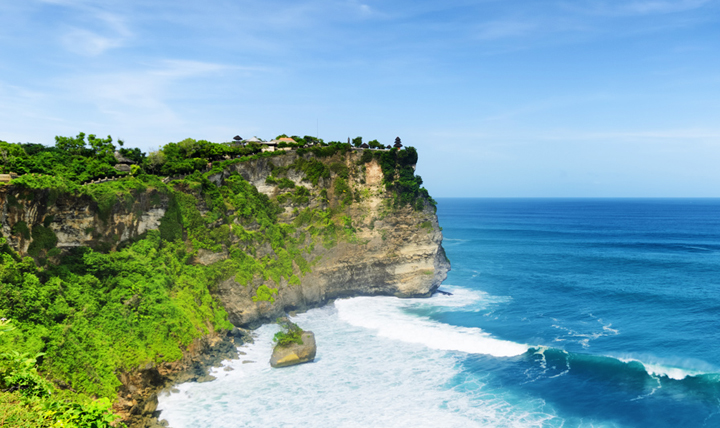
Pingback: Tanah Lot Temple – BALIDENS